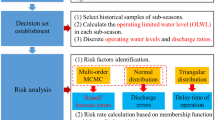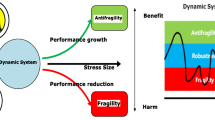Abstract
The operation of cascade hydropower stations is accompanied by various target risks while exerting the comprehensive benefits of water resources. The systematic analysis of multi-risk interactions in system operation can improve the operational benefit of hydropower stations. However, the current hydropower operating model used for risk simulation cannot show the dynamic operation processes within the system, which may limit the popularization of the model. In addition, most existing studies define risk from the perspective of reliability and lack analyses of risk resilience and vulnerability. In this study, a system dynamics model for cascade hydropower stations and a unified multi-objective performance index system are constructed. The relationships among the multi-risk of the Xiluodu-Xiangjiaba (XLD-XJB) cascade hydropower stations are explored from the aspects of reliability, resilience and vulnerability. The results are as follows. (1) The system dynamics model can effectively simulate the dynamic process of system operation and can be used to study the performance risk changes in the operation process of hydropower stations. (2) The current operating rule leads to ecological risk and shipping risk in the system in the normal scenario. There are also power risks in wet and dry scenarios. (3) There is a contradiction between power risk and shipping risk. In addition, in the case of insufficient inflow, there is a contradiction between the reliability and vulnerability of power risk. (4) The regulation of ecological risk helps reduce shipping risk and power risk. Therefore, ecological outflow should be regarded as the minimum outflow requirement of cascade hydropower stations.
Highlights
Based on system dynamics, a simulation model is constructed to reflect the operation dynamic process of cascade hydropower stations.
A multi-performance evaluation index system suitable for reliability, resilience and vulnerability risk evaluation is developed.
Through the simulation of operating rules with different risk control priorities, the dynamic relationships among multi-risk are analyzed.





Similar content being viewed by others
Data Availability
Some or all data, models, or code that support the findings of this study are available from the corresponding author upon reasonable request.
References
Alehu BA, Bitana SGJEP (2023) Assessment of climate change impact on water balance of Lake Hawassa Catchment. Environ Processes 10(1):14
Chen J, Zhong PA, Liu WF, Wan XY, Yeh WWG (2020) A multi-objective risk management model for real-time flood control optimal operation of a parallel reservoir system. J Hydrol 590:14
Choo TH, Huh JY, Yoon HC, Yun GS, Son JK (2016) Method for new conceptual securing water resources: a case study of the Miryang multipurpose dam in Korea. Environ Earth Sci 75(10):18
Fathian F, Ahmadzadeh H, Mansouri B, Vaheddoost B (2022) Assessment of water demand reliability using SWAT and RIBASIM models with respect to climate change and operational water projects. Agric Water Manage 261:11
Fayaed SS, El-Shafie A, Jaafar O (2013) Reservoir-system simulation and optimization techniques. Stoch Env Res Risk Assess 27(7):1751–1772
Ghandehari A, Davary K, Khorasani HO, Vatanparast M, Pourmohamad YJEP (2020) Assessment of urban water supply options by using fuzzy possibilistic theory. Environ Processes 7:949–972
Gobbetti LECJJ, o. AWE, Research (2018) Application of HEC-ResSim in the study of new water sources in the Panama Canal. J Appl Water Eng Res 6(3):236–250
Gowda CC, Mayya SG (2015) “Evaluation of the Small Storage Reservoirs during its Operation in Series for Non Monsoon Periods.” International Conference on Water Resources, Coastal and Ocean Engineering (ICWRCOE), Natl Inst Technol Karnataka, Mangaluru, INDIA, 1150–1154
Hashimoto T, Stedinger JR, Loucks DP (1982) Reliability, resiliency, and vulnerability criteria for water resource system performance evaluation. Water Resour Res 18(1):14–20
Hogeboom RJ, Knook L, Hoekstra AY (2018) The blue water footprint of the world’s artificial reservoirs for hydroelectricity, irrigation, residential and industrial water supply, flood protection, fishing and recreation. Adv Water Resour, 285–294
Jiang H, Simonovic SP, Yu Z, Wang W (2020a) A system dynamics simulation approach for environmentally friendly operation of a reservoir system. J Hydrol, 587
Jiang HY, Simonovic SP, Yu ZB, Wang WG (2020b) System Dynamics Simulation Model for Flood Management of the three Gorges Reservoir. J Water Resour Plan Manag 146(7):13
King LM, Simonovic SP, Hartford DND (2017) Using system dynamics simulation for assessment of hydropower system safety. Water Resour Res 53(8):7148–7174
Li JQ, Huang J, Liang PT, Lund JR (2021) Fuzzy representation of Environmental Flow in Multi-Objective Risk Analysis of Reservoir Operation. Water Resour Manage 35(9):2845–2861
Liu DD (2019) Evaluating the dynamic resilience process of a regional water resource system through the nexus approach and resilience routing analysis. J Hydrol 578:13
Ma Q, Li R, Feng J, Lu J, Zhou Q (2019) Ecological regulation of cascade hydropower stations to reduce the risk of supersaturated total dissolved gas to fish. J Hydro-Environ Res 27:102–115
Moriasi DN, Arnold JG, Van Liew MW, Bingner RL, Harmel RD, Veith TL (2007) Model evaluation guidelines for systematic quantification of accuracy in watershed simulations. Trans Asabe 50(3):885–900
Qiu HY, Chen L, Zhou JZ, He ZZ, Zhang HS (2021) Risk analysis of water supply-hydropower generation-environment nexus in the cascade reservoir operation. J Clean Prod 283:13
Teegavarapu RSV, Simonovic SP (2014) Simulation of multiple hydropower Reservoir Operations using System Dynamics Approach. Water Resour Manage 28(7):1937–1958
Zhang HX, Ge W, Zhang YD, Li ZK, Li W, Zhu JY, Wang WQ (2023) Risk management decision of Reservoir Dams based on the Improved Life Quality Index. Water Resour Manage 37(3):1223–1239
Zhu B, Liu J, Lin J, Liu Y, Zhang D, Ren Y, Peng Q, Yang J, He H, Feng Q (2022) Cascade reservoirs adaptive refined simulation model based on the mechanism-AI coupling modeling paradigm. J Hydrol, 612
Funding
This work was financially supported by the National Key R&D Program of China (2021YFC3200304), the National Natural Science Foundation of China (NO.52192672), and the Science and Technology Project of Huaneng Group Headquarters (HNKJ20-H26).
Author information
Authors and Affiliations
Contributions
Conceptualization and writing: Boran Zhu and Junqiang Lin; Methodology: Yi Liu, Di Zhang, Yufeng Ren, and Yi Xu; Funding acquisition: Qidong Peng and Jiejie Chen.
Corresponding author
Ethics declarations
Ethical Approval
Not applicable.
Consent to Participate
Not applicable.
Consent for Publication
Not applicable.
Conflict of Interest
The authors declare that they have no competing interests.
Additional information
Publisher’s Note
Springer Nature remains neutral with regard to jurisdictional claims in published maps and institutional affiliations.
Rights and permissions
Springer Nature or its licensor (e.g. a society or other partner) holds exclusive rights to this article under a publishing agreement with the author(s) or other rightsholder(s); author self-archiving of the accepted manuscript version of this article is solely governed by the terms of such publishing agreement and applicable law.
About this article
Cite this article
Zhu, B., Lin, J., Liu, Y. et al. Multi-Risk Interaction Analysis of Cascade Hydropower Stations Based on System Dynamics Simulation. Water Resour Manage 38, 45–62 (2024). https://doi.org/10.1007/s11269-023-03628-4
Received:
Accepted:
Published:
Issue Date:
DOI: https://doi.org/10.1007/s11269-023-03628-4




